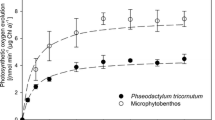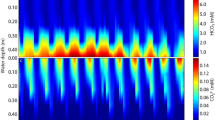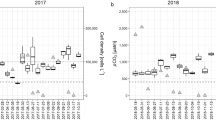Summary
Photosynthetic kinetics with respect to dissolved inorganic carbon were used to predict the outcome of competition for DIC between the green alga Selenastrum minutum and the cyanobacterium Synechococcus leopoliensis at pH 6.2, 7.5, and 10. Based on measured values of the maximum rate of photosynthesis, the half-saturation value of photosynthesis with respect to DIC (K 2/DIC1 ), and the DIC compensation point, it was predicted that S. leopoliensis would lower the steady-state DIC concentration below the DIC compensation point of S. minutum. This should result in competitive displacement of the green alga at a rate equivalent to the chemostat dilution rate. This prediction was validated by carrying out competition experiments over the range of pH. These results suggest that the low levels of DIC in air-equilibrated acidified lakes may be an important rate-limiting resource and hence affect phytoplankton community structure. Furthermore, the low levels of DIC in these systems may be below the DIC compensation point for some species, thereby precluding their growth at acid pH solely as a function of DIC limitation. The potential importance of DIC in shaping phytoplankton community structure in acidified systems is discussed.
Similar content being viewed by others
Abbreviations
- μ:
-
growth rate
- μmax :
-
maximum growth rate
- K μ :
-
concentration of dissolved inorganic carbon required to maintain half-maximal rate of growth
- K 2/DIC1 :
-
concentration of dissolved inorganic carbon required to maintain half-maximal photosynthesis
- DIC:
-
dissolved inorganic carbon
- P max :
-
maximum rate of photosynthesis
- R * :
-
substrate concentration required for an organism to maintain a growth rate equal to the mortality rate
- τ:
-
DIC compensation point (DIC) concentration where gross photosynthesis equals respiration
- i.e.:
-
net photosynthesis equals zero
References
Allen MM (1968) Simple conditions for the growth of unicellular blue-green algae on plates. J Phycol 4:1–4
Birmingham BC, Colman B (1979) Measurement of carbon dioxide compensation points of freshwater algae. Plant Physiol 64:892–895
Brock TD (1973) Lower pH limit for the existence of blue-green algae: evolutionary and ecological implications. Science 179:480–483
Burris JE, Wedge R, Lane A (1981) Carbon dioxide limitation of photosynthesis of freshwater phytoplankton. J Freshwater Ecol 1:81–96
Charles D (1982) Studies of Adirondack mountain (New York) Lakes: Limnological characteristics and sediment. Thesis Indiana University p 428
Cohen RRH, Kelly MG, Church MR (1982) The effect of CO2 on the relationship of photosynthetic rate to light intensity in laboratory phytoplankton cultures. Arch Hydrobiol 94:326–340
Goldman JC, Graham SJ (1981) Inorganic carbon limitation and chemical composition of two freshwater green microalgae. Appl Environ Microbiol 41:60–70
Goldman JC, Oswald WL, Jenkins D (1974) The kinetics of inorganic carbon limited algal growth. J Water Poll Control Fed 46:554–574
Healey FP (1980) Slope of the Monod equation as an indicator of advantage in nutrient competition. Microb Ecol 5:281–286
Johnson MG, Michalski MFP, Christie AE (1970) Effects of acid mine wastes on phytoplankton communities of two northern Ontario lakes. J Fish Res Board Canada 27:425–444
Kaplan A, Badger MR, Berry JA (1980) Photosynthesis and the intracellular inorganic carbon pool in the blue-green alga Anabaena variabilis: response to external CO2 concentrations. Planta 149:219–226
Kwiatkowski RE, Roff JC (1976) Effects of acidity on the phytoplankton and primary productivity of selected northern Ontario lakes. Can J Bot 54:2546–2561
Mayo WP, Williams TG, Birch DG, Turpin DH (1986) Photosynthetic adaptation by Synechococcus leopoliensis in response to exogenous dissolved inorganic carbon. Plant Physiol 80:1038–1040
Miller AG, Turpin DH, Canvin DT (1984) Growth and photosynthesis of the cyanobacterium Synechococcus leopoliensis in HCO -3 -limited chemostats. Plant Physiol 75:1064–1070
Miyachi S, Tsuzuki M, Avramova ST (1983) Utilization modes of inorganic carbon for photosynthesis in various species of Chlorella. Plant and Cell Physiol 24:441–451
Monod J (1942) Recherches sur le Croissance des cultures Bacteriennes. Hermann et Cie., Paris, p 210
Muller P (1980) Effects of artificial acidification on the growth of periphyton. Can J Fish Aquat Sci 37:355–363
O'Brien WJ (1972) Limiting factors in phytoplankton algae: Their meaning and measurements. Science 178:616–617
Paerl HW (1982) Factors limiting productivity of freshwater ecosystems. Adv in Microbial Ecol 6:75–110
Reynolds CS (1984) The ecology of freshwater phytoplankton. Cambridge University Press, London, p 384
Schindler DW (1972) Carbon, nitrogen and phosphorus and the eutrophication of freshwater lakes. J Phycol 7:321–329
Schindler DW, Fee EJ (1973) Diurnal variation of dissolved inorganic carbon and its use in estimating primary productivity and CO2 invasion in lake 227. J Fish Res Board Canada 30:1501–1510
Stumm W, Morgan JJ (1981) Aquatic Chemistry John Wiley and Sons New York, p 780
Tilman D (1977) Resource competiton between planktonic algae: An experimental and theoretical approach. Ecology 58:338–348
Tilman D (1981) Tests of resource competition theory using four species of Lake Michigan algae. Ecology 62:802–815
Turpin DH, Miller AG, Canvin DT (1985a) The use of chemostats in the study of inorganic carbon metabolism by microalgae. In: Lucas W, Berry J (eds) Bicarbonate Utilization by Photosynthetic Organisms Waverly Press, Baltimore
Turpin DH, Miller AG, Parslow JS, Elrifi IR, Canvin DT (1985b) Predicting the kinetics of dissolved inorganic carbon limited growth from the short-term kinetics of photosynthesis in Synechococcus leopoliensis (Cyanophyta). J Phycol 21:409–418
Author information
Authors and Affiliations
Rights and permissions
About this article
Cite this article
Williams, T.G., Turpin, D.H. Photosynthetic kinetics determine the outcome of competition for dissolved inorganic carbon by freshwater microalgae: implications for acidified lakes. Oecologia 73, 307–311 (1987). https://doi.org/10.1007/BF00377523
Received:
Issue Date:
DOI: https://doi.org/10.1007/BF00377523




